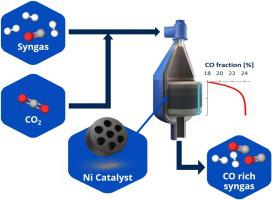Catalysis Today ( IF 5.2 ) Pub Date : 2020-07-30 , DOI: 10.1016/j.cattod.2020.07.024 Peter Mølgaard Mortensen , Marené Rautenbach

|
Feasible process conditions for reforming of gas mixtures of CH4 and CO2 into CO-rich synthesis gas are dictated by the risk of carbon formation. To overcome this risk, a minimum steam requirement exists for the process as determined by thermodynamic considerations. This work describes an approach for using a well-known nickel-based catalyst system to enable production of CO-rich synthesis gas at low steam-to-hydrocarbon-carbon (S/C) ratios. The concept utilizes a two-reactor approach where traditional steam reforming is done initially, followed by CO2 addition to the hot synthesis gas and subsequent conversion in an adiabatic reactor, a so-called Adiabatic POst Converter (APOC). This allows for operating at overall S/C ratios of below 1.5; which is much lower than what is possible in a conventional fired reformer. The central element of the APOC is that the temperature is kept higher than 700–800 °C to circumvent the carbon limits. The process elements were demonstrated by a combination of thermodynamic calculations, process calculations, and laboratory experiments. The concept allows for design of significantly more compact reformers (up to 30 % reduced size), which in turn also reduces firing and thereby CO2 emissions. The concept can also be used in existing plants where the capacity can be boosted by adding an APOC.
中文翻译:

绝热后转化反应器在甲烷CO 2重整中规避碳形成
将CH 4和CO 2的气体混合物重整为富含CO的合成气的可行工艺条件取决于形成碳的风险。为了克服该风险,通过热力学考虑确定该过程的最低蒸汽需求。这项工作描述了一种使用众所周知的镍基催化剂系统的方法,该方法能够以低的蒸汽与烃碳(S / C)比率生产富含CO的合成气。该概念利用了两反应器方法,该方法首先进行传统的蒸汽重整,然后再进行CO 2转化。除了热合成气和在绝热反应器中的后续转化,即所谓的绝热POst转化器(APOC)。这样可以在低于1.5的总S / C比下运行;这比传统的燃烧重整器要低得多。APOC的中心要素是保持温度高于700–800°C以规避碳限制。通过热力学计算,过程计算和实验室实验的结合证明了过程要素。该概念允许设计更紧凑的重整器(尺寸减小多达30%),这反过来又减少了燃烧,从而减少了CO 2排放。该概念还可以用于现有工厂,在这些工厂中,可以通过添加APOC来提高产能。











































 京公网安备 11010802027423号
京公网安备 11010802027423号